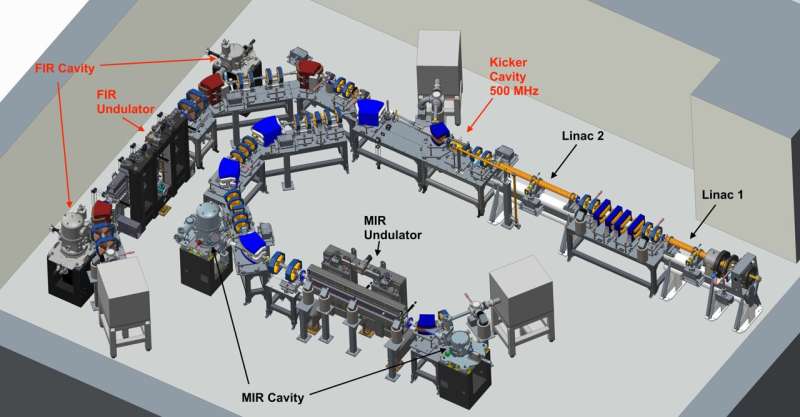This article has been reviewed according to Science X's editorial process and policies. Editors have highlighted the following attributes while ensuring the content's credibility:
fact-checked
trusted source
proofread
First operation of a two-color mode in an infrared free-electron laser

A technological milestone has been achieved at the Fritz Haber Institute (FHI) of the Max Planck Society in Berlin. For the first time, an infrared free-electron laser (FEL) has been operated in a two-color mode. This globally unique technology enables experiments with synchronized two-color laser pulses, opening up new possibilities in research.
Free-electron lasers, of which there are more than a dozen worldwide, vary significantly in size (from a few meters to several kilometers), wavelength range (from microwaves to hard X-rays), and costs (from millions to more than a billion). However, they all produce intense, short radiation pulses. Free-electron lasers have become important radiation sources over the past decades, finding broad applications in basic research and applied sciences.
Researchers at the FHI have now developed a method in collaboration with American partners that allows for the simultaneous generation of infrared pulses in two different colors. This innovation is particularly important for the study of temporal processes in solids and molecules.
In an FEL, electron bunches are first accelerated to very high kinetic energies by an electron accelerator, reaching nearly the speed of light. Then, the fast electrons pass through an undulator, where they are forced onto a slalom-like path by strong magnetic fields of periodically varying polarity.
The oscillations of the electrons lead to the emission of electromagnetic radiation, whose wavelength can be varied by adjusting the electron energy and/or the magnetic field strength. For this reason, FELs can be used to generate laser-like radiation in almost all parts of the electromagnetic spectrum, from long terahertz to short X-ray wavelengths.
Since 2012, an FEL has been in operation at the FHI, producing intense, pulsed radiation in the mid-infrared (MIR) range, continuously tunable from 2.8 to 50 micrometers in wavelength. In recent years, scientists and engineers at the FHI have worked on a two-color expansion in which a second FEL branch has been installed to generate radiation in the far infrared (FIR) at wavelengths between 5 and 170 micrometers.
The FIR-FEL branch includes a new hybrid magnet undulator, which was specially built at the FHI. Furthermore, a 500-MHz kicker cavity for the transverse deflection of the electrons was installed behind the electron linear accelerator (LINAC). The kicker cavity can change the direction of the high-energy electron bunches at a rate of 1 billion times per second.
In June 2023, the FHI team demonstrated the first "lasing" of the new FIR-FEL, directing all electron bunches coming from the LINAC to the FIR-FEL. In December 2023, they were able to demonstrate the two-color operation for the first time. In this mode, the strong oscillating electric field formed in the kicker cavity deflects every second electron bunch to the left and every other second bunch to the right.
This way, the high-repetition-rate (1 GHz; 1 bunch per ns) electron bunch train coming from the LINAC is split into two bunch trains of half the repetition rate each; one is steered to the old MIR-FEL, and the other to the new FIR-FEL. In each FEL, varying the undulator magnetic field strength allows for continuous tuning of the wavelength by up to a factor of four.
For about a decade, the FHI-FEL has enabled research groups at the FHI to conduct experiments ranging from spectroscopy of clusters, nanoparticles, and biomolecules in the gas phase to nonlinear solid-state spectroscopy and surface science, resulting in approximately 100 peer-reviewed publications so far.
The new two-color mode, not available at any other IR FEL facility around the world, will enable novel experiments such as MIR/MIR and MIR/FIR pump-probe experiments. This is expected to open new opportunities for experimental studies in diverse fields ranging from physical chemistry, materials science, catalysis research to biomolecular studies, thereby contributing to the development of new materials and medicines.
Provided by Max Planck Society




















